Abstract
To analyse the effects of apnoea and bradycardia on the oxygen saturation (SaO2) of preterm infants and to make recommendations for apnoea alarm limits, polygraphic recordings were made on 89 occasions of 27 preterm infants; 1029 apnoeic episodes were analysed. Reduction in SaO2 was positively correlated with duration of apnoea, but the scatter of results was such that reductions in SaO2 of up to 40% occurred with apnoeas of less than 10 seconds duration. The median initial SaO2 was significantly lower in those episodes that resulted in bradycardia (92% compared with 95%), and there was also a significantly greater reduction in median SaO2 (9% compared with 5%). This study illustrates the difficulty of setting alarm limits for the detection of apnoea. We suggest that rather than simply detecting apnoea it is more appropriate to monitor heart rate and SaO2 in infants with recurrent apnoea.
Full text
PDF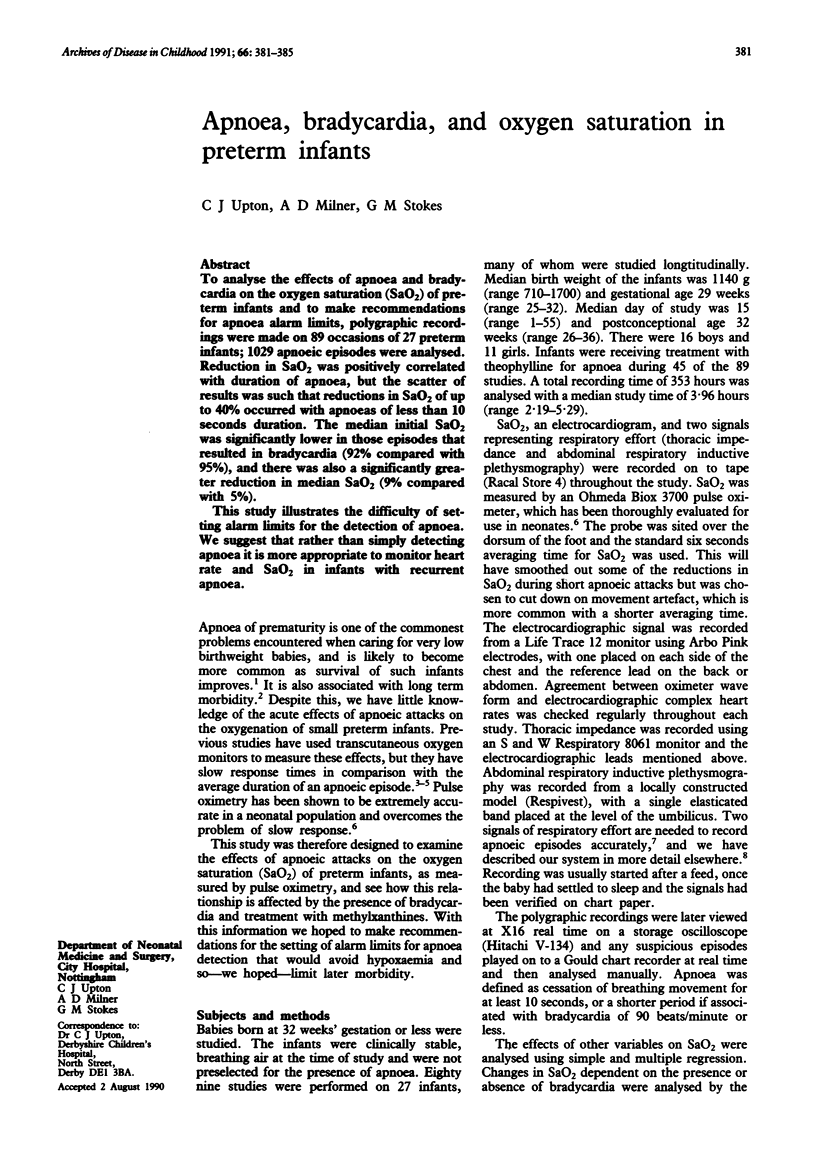
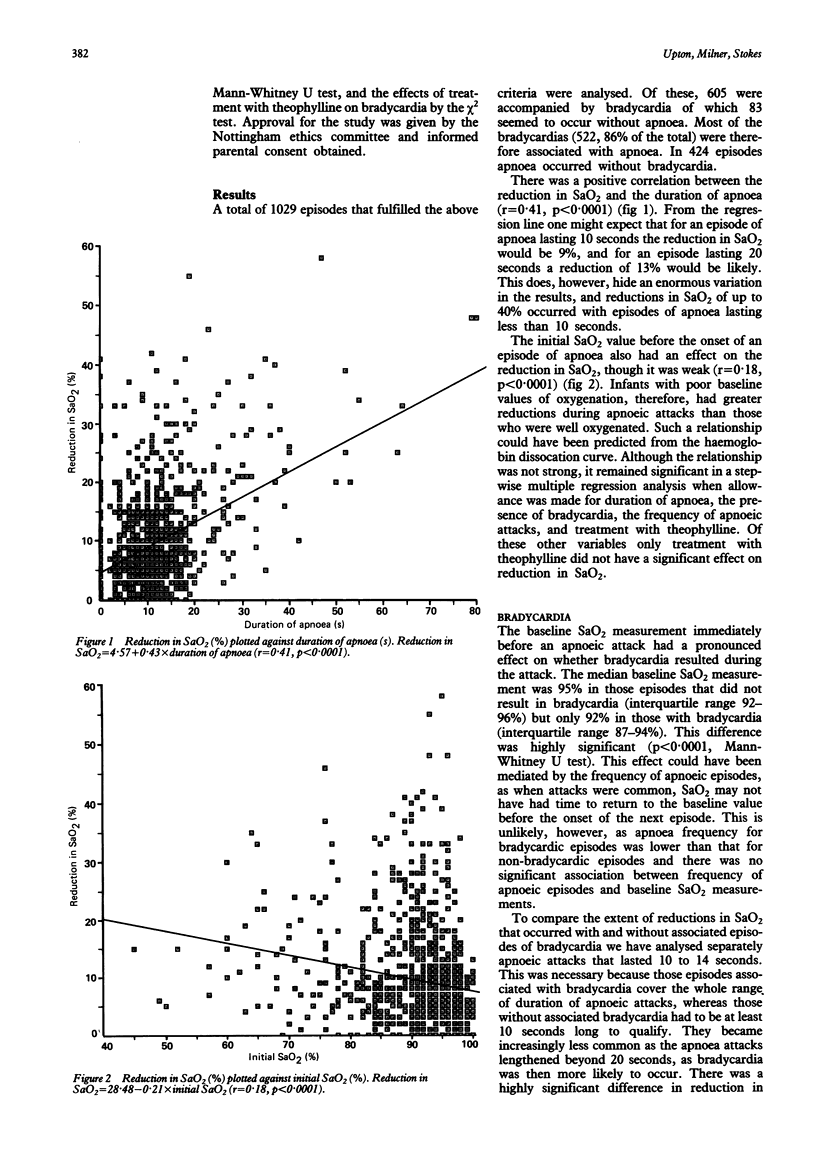
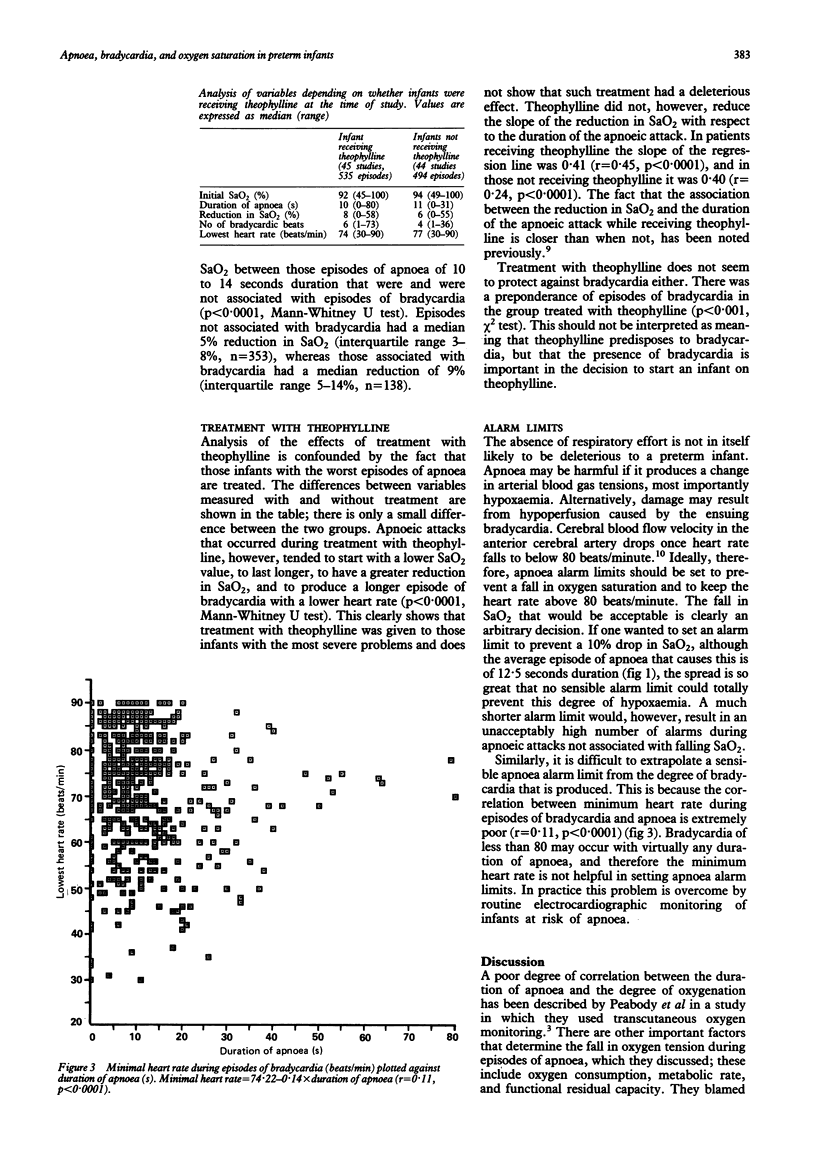
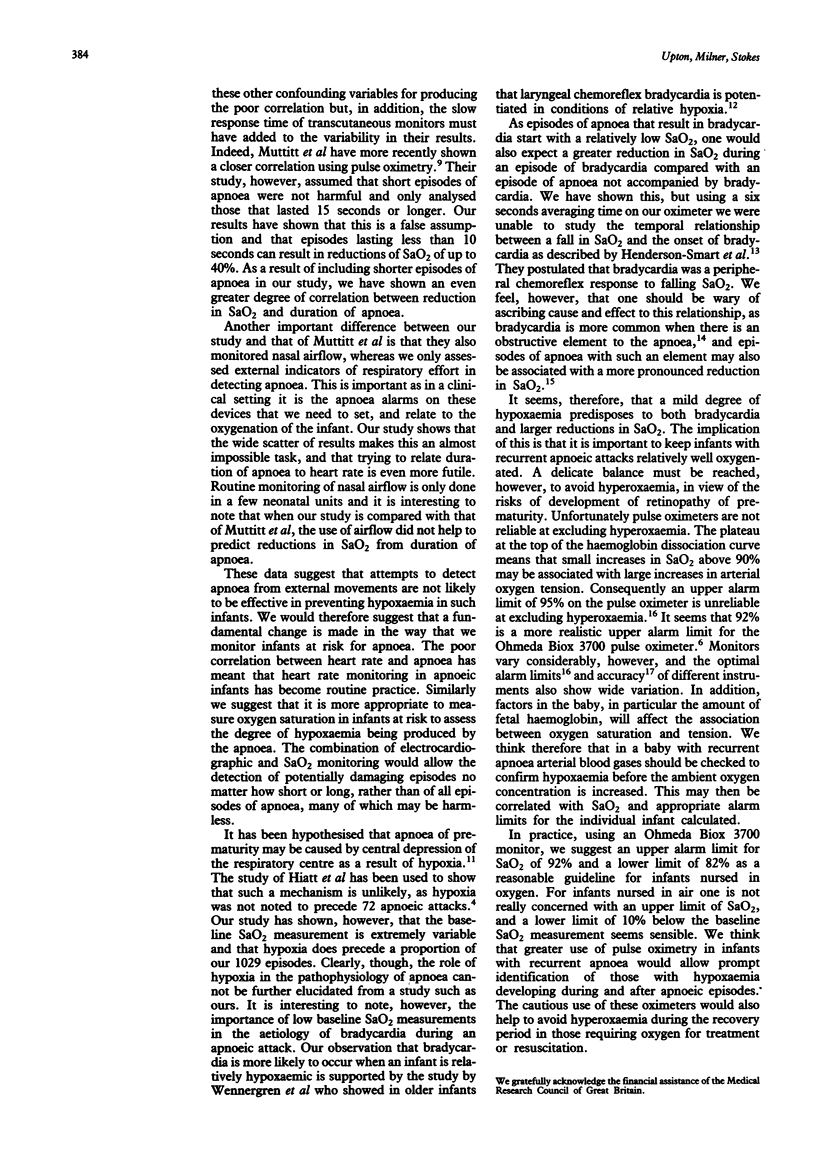
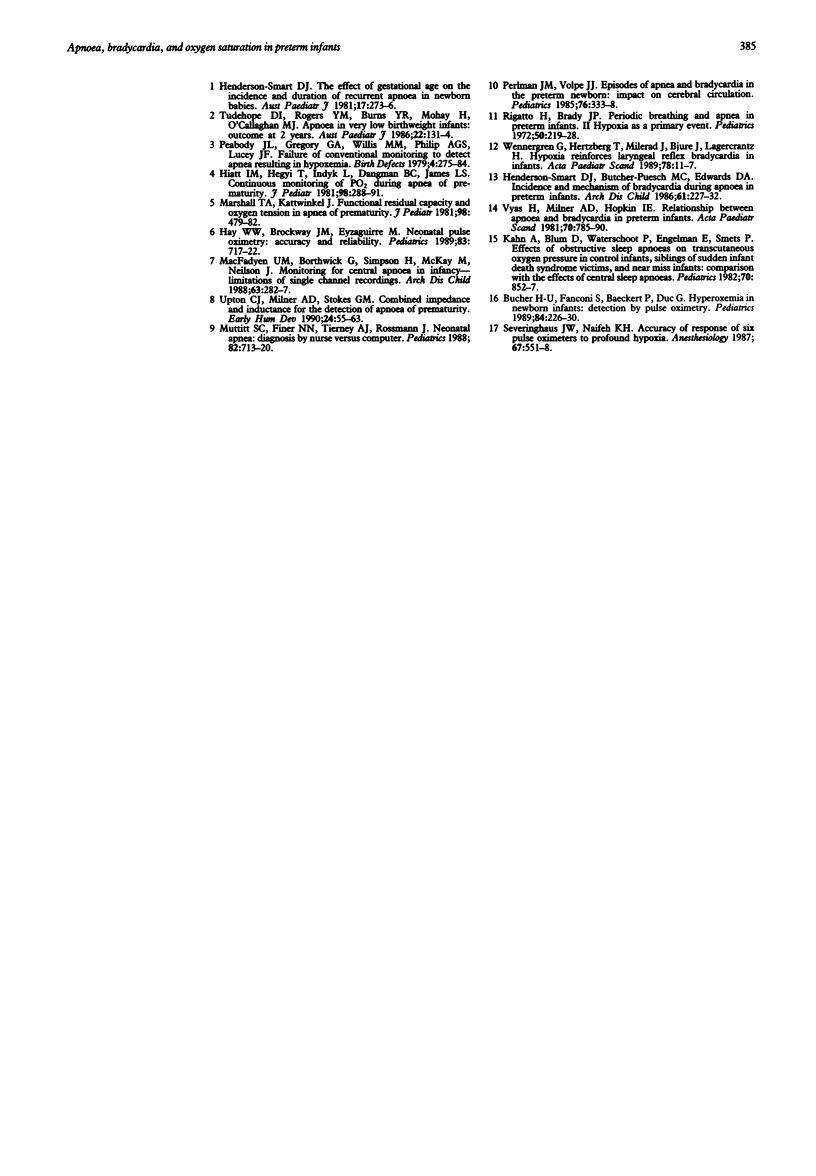
Selected References
These references are in PubMed. This may not be the complete list of references from this article.
- Bucher H. U., Fanconi S., Baeckert P., Duc G. Hyperoxemia in newborn infants: detection by pulse oximetry. Pediatrics. 1989 Aug;84(2):226–230. [PubMed] [Google Scholar]
- Hay W. W., Jr, Brockway J. M., Eyzaguirre M. Neonatal pulse oximetry: accuracy and reliability. Pediatrics. 1989 May;83(5):717–722. [PubMed] [Google Scholar]
- Henderson-Smart D. J., Butcher-Puech M. C., Edwards D. A. Incidence and mechanism of bradycardia during apnoea in preterm infants. Arch Dis Child. 1986 Mar;61(3):227–232. doi: 10.1136/adc.61.3.227. [DOI] [PMC free article] [PubMed] [Google Scholar]
- Henderson-Smart D. J. The effect of gestational age on the incidence and duration of recurrent apnoea in newborn babies. Aust Paediatr J. 1981 Dec;17(4):273–276. doi: 10.1111/j.1440-1754.1981.tb01957.x. [DOI] [PubMed] [Google Scholar]
- Hiatt I. M., Hegyi T., Indyk L., Dangman B. C., James L. S. Continuous monitoring of PO2 during apnea of prematurity. J Pediatr. 1981 Feb;98(2):288–291. doi: 10.1016/s0022-3476(81)80663-4. [DOI] [PubMed] [Google Scholar]
- Kahn A., Blum D., Waterschoot P., Engelman E., Smets P. Effects of obstructive sleep apneas on transcutaneous oxygen pressure in control infants, siblings of sudden infant death syndrome victims, and near miss infants: comparison with the effects of central sleep apneas. Pediatrics. 1982 Dec;70(6):852–857. [PubMed] [Google Scholar]
- MacFadyen U. M., Borthwick G., Simpson H., McKay M., Neilson J. Monitoring for central apnoea in infancy--limitations of single channel recordings. Arch Dis Child. 1988 Mar;63(3):282–287. doi: 10.1136/adc.63.3.282. [DOI] [PMC free article] [PubMed] [Google Scholar]
- Marshall T. A., Kattwinkel J. Functional residual capacity and oxygen tension in apnea of prematurity. J Pediatr. 1981 Mar;98(3):479–482. doi: 10.1016/s0022-3476(81)80729-9. [DOI] [PubMed] [Google Scholar]
- Muttitt S. C., Finer N. N., Tierney A. J., Rossmann J. Neonatal apnea: diagnosis by nurse versus computer. Pediatrics. 1988 Nov;82(5):713–720. [PubMed] [Google Scholar]
- Perlman J. M., Volpe J. J. Episodes of apnea and bradycardia in the preterm newborn: impact on cerebral circulation. Pediatrics. 1985 Sep;76(3):333–338. [PubMed] [Google Scholar]
- Rigatto H., Brady J. P. Periodic breathing and apnea in preterm infants. II. Hypoxia as a primary event. Pediatrics. 1972 Aug;50(2):219–228. [PubMed] [Google Scholar]
- Severinghaus J. W., Naifeh K. H. Accuracy of response of six pulse oximeters to profound hypoxia. Anesthesiology. 1987 Oct;67(4):551–558. doi: 10.1097/00000542-198710000-00017. [DOI] [PubMed] [Google Scholar]
- Tudehope D. I., Rogers Y. M., Burns Y. R., Mohay H., O'Callaghan M. J. Apnoea in very low birthweight infants: outcome at 2 years. Aust Paediatr J. 1986 May;22(2):131–134. doi: 10.1111/j.1440-1754.1986.tb00204.x. [DOI] [PubMed] [Google Scholar]
- Upton C. J., Milner A. D., Stokes G. M. Combined impedance and inductance for the detection of apnoea of prematurity. Early Hum Dev. 1990 Oct;24(1):55–63. doi: 10.1016/0378-3782(90)90006-5. [DOI] [PubMed] [Google Scholar]
- Vyas H., Milner A. D., Hopkin I. E. Relationship between apnoea and bradycardia in preterm infants. Acta Paediatr Scand. 1981 Nov;70(6):785–790. doi: 10.1111/j.1651-2227.1981.tb06229.x. [DOI] [PubMed] [Google Scholar]
- Wennergren G., Hertzberg T., Milerad J., Bjure J., Lagercrantz H. Hypoxia reinforces laryngeal reflex bradycardia in infants. Acta Paediatr Scand. 1989 Jan;78(1):11–17. doi: 10.1111/j.1651-2227.1989.tb10879.x. [DOI] [PubMed] [Google Scholar]


